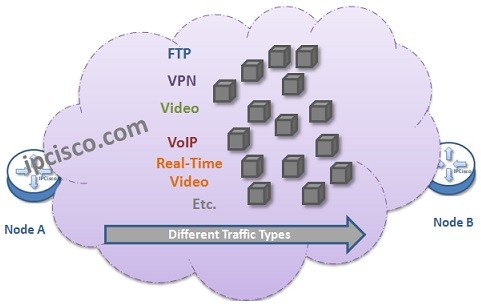Table of Contents
What Does QoS Stand For?
This is th most ask questions by Network Engineers, especially the Newbies, What Does QoS Stand For?QoS (Quality of Service) is the general name of a concept , which is used to optimize networks with different priority levels to different applications and provide improved services for these appliations on these networks. From the view point of customer, with QoS, users get a better performance without drops, packet loss, unaccepted delays etc. From the view point of your Service Provider company, with QoS, you can use your networks more efficient. With optimized network bandwidh and with a best performance.
After answering what ooes qoS stand for question, now let’s focus on some terms, QoS Enemies in QoS. QoS (Quality of Service) adjusts some important QoS Enemies for the traffic mainly. With this adjustments, networks become more efficient.
These important QoS enemies are given below:
• Packet Loss
• Jitter
• Delay
So, what are these terms?
Packet Loss : Losing the packets along the path.
Delay : The time taken from one point to the other along the path.
Jitter : Variable Delay in packet transfer.
There are various types of traffics like real-time voice, data, streaming video etc. All of these traffic types need different QoS adjustments. Some of these traffics are very senstive to delay, some of them are not. Another is senstive to packet loss, for the other, packet loss is not too important.

Let’s give some examples for these different types of traffic to understand better.
As you know, voice is a real-time traffic. When you talk with another people, the vioce data is created at that time interactively by you and this traffic needs to reach to the other end in a very short time. If this is not achieved, then it is not possible to communicate with the person at the other end. So, voice traffic is senstive for delays. Beside, your voice data must not have a variable delays, jitter. Because, this also makes the communication worst. Lastly, for a good communication, your sentences need to be clear without any loss. All your talking need to be heared at the other end. This makes voice traffic also packet loss senstive.
QoS Service Models
QoS (Quality of Service) can be implemented with different Service Models. There are three main QoS Service Models. These QoS Service Models are given below:
• Best Effort
• Integrated Services
• Differentiated Services
Best Effort is the simplest Service Model. It is also known as a model without QoS. In other words, thi sis the model that there is no QoS Adjustments.
In this model, all the traffic are seem similar. So, all the behaviours are same to all types of traffics. The only parameter is the time. In Best Effort traffic, always the first come packets, are sent firstly.
Integrated Services is the second QoS Model in which, applications requests QoS from the network’s control plane. With an explicit signalling, Integrated Services QoS instruct the network that it need QoS. In other words, it requests a reservation. For this explicit signalling, RSVP (Resource Reservation Protocol) is used. After this request, it gets specific QoS parameters associated to that traffic and after the confirmation, the data is sent.
Differentiated Services is the third QoS Model. In this model, there is no prior reservation technique. In Differentiated Services Model, the network classifies the different types of traffic into groups. After that it marks these groups with DSCP values. All the groups are behaved with different QoS values. There is no explicit signalling before the data sent in Differentiated Services. And Differentiated Services is implemented per hop. Differentiated Services uses DS Feilds in ToS (Type of Service) field.
As a summary, you can find the below comparison of Integrated Services and Differentiated Services.













Leave a Reply